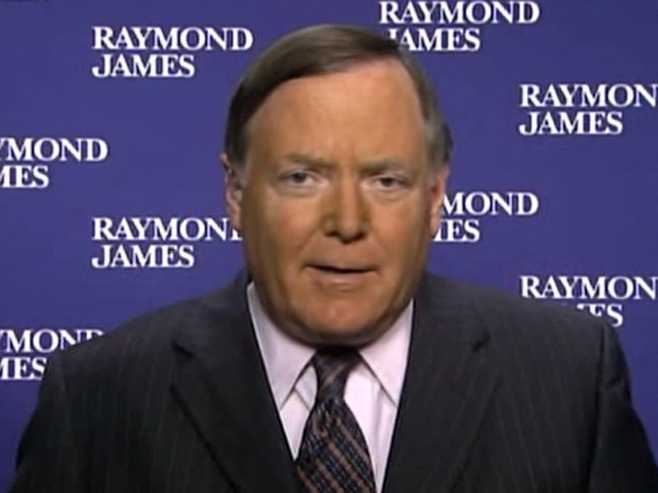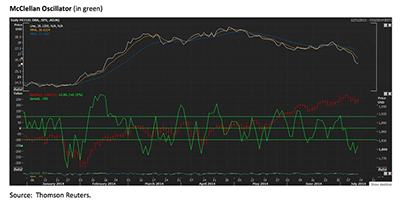Fireside Chats
July 14, 2014
by Jeffrey Saut, Chief Investment Strategist, Raymond James
The “Fireside Chats” were a series of thirty evening radio addresses given by President Franklin D. Roosevelt between 1933 and 1944. Although the World War I Committee on Public Information had seen presidential policy propagated to the public en masse, "fireside chats" were the first media development that facilitated intimate and direct communication between the president and the citizens of the United States. Roosevelt's cheery voice, and demeanor, played him into the favor of citizens and he soon became one of the most popular presidents ever; often affectionately compared to Abraham Lincoln. On radio, he was able to quell rumors and explain his reasons for social change slowly and comprehensibly. Radio was especially convenient for Roosevelt because it enabled him to hide his polio symptoms from the public eye.
... Wikipedia
While I was in the Pacific Northwest and Canada most of last week, I did have the privilege of listening to J.P. Morgan’s (JPM/$55.80/Strong Buy) Chief Market Strategist last Monday. Dr. David Kelly has long been known for his keen insights on the equity markets, with JPM’s senior portfolio managers like George Gatz and Tom Luddy steering their mutual funds, on said strategic views, to outsized gains for many years. Dr. Kelly began last week’s “Fireside Chat” by noting, “There are basically six themes.” First, the U.S. economy is set up for a rebound. Second, the direction of interest rates is likely higher. Third, you should be cautiously over-weighted equities. Fourth, valuations, while pretty close to historic medians, are still cheap when compared to fixed income yields given the S&P 500’s (SPX/1967.57) earning’s yield of more than 6% based on forward earning’s estimates. Fifth, international markets are doing better on a cyclical and secular basis, and offer a lot less “cyclical drag” going forward. And sixth, as the U.S. economy moves toward full employment, the Federal Reserve is out of “running room.”
Before beginning his discussion, Dr. Kelly said the most important slides in the attendant slide deck were slides 7, 8, 17, 24, 27, 31, 33, 43, 52, and 58. Speaking to his first point David stated that while the economic rebound is below historical trend, the recent -2.9% negative GDP report does not “foot” with most of the other economic reports. Speaking to point 2 (grey line page 27), though core inflation is low, and low inflation equates to low interest rates, the Fed is currently too conservative because “real” inflation is higher than the Fed thinks. Accordingly, nominal interest rates should move higher going forward. The reason they are not currently rising is because the Fed is still buying bonds and the supply is about one-third of what it was a few months ago (read: more demand than supply). That creates an artificial demand that is going to disappear this fall when the Fed’s tapering maneuvers cease.
To point three, Dr. Kelly suggests being mildly overweight U.S. equities (page 8) because while valuations are pretty close to historic norms, earnings yields when compared to bond yields are tilted largely in favor of stocks, thus rendering an overweight to equities. On page 11 of the guide the charts show value stocks versus growth stocks. In a rising inflationary environment “growth stocks” tend to do better than “value stocks.” However, Dr. Kelly noted that U.S. growth stocks are not as “cheap” as they have been over the past few years so investors should consider international growth stocks. Speaking to that international point, on page 43 of the guide he stated that China is doing better with PMIs up for three months in a row and that Taiwan is also improving. Moreover, Europe is doing better (page 48) as the sovereign debt crisis mitigates (page 49). He emphasized that emerging markets had improving demographics, earnings, and valuations metrics (page 52 and 53). In the U.S. he suggested profits are setting up to surge as we move into a full employment situation where unemployment should drop to 5.4%. Again he emphasized that the Fed is out of running room!
Turning to commodities (page 63), the good doctor suggested increasing portfolio weightings to “stuff” (my term of 15 years) while noting the real estate investment trust complex (REITs) does well in the economic environment he envisions in the years ahead; and, that cap rates are still very high at 6.6% (page 58). He concluded that fixed income should be in VERY short-duration bonds and that as he looks around the world he sees more economic growth on a secular basis than a cyclical basis, suggesting a large underweight to bonds. Above all, he thinks investors need to be diversified, and since “cash” has negative investment returns, investors should be invested in something else. And with that last line I find it very interesting where “The 1%” are parking their money.
Indeed, in a recent study on “The 1%” by Cap Gemini and RBC Wealth Management the survey showed that wealthy global investors are keeping an eye-popping 28% of their wealth in cash or cash equivalents. That’s more than their holdings in real estate (20%) or equities (26%); other surveys have shown the same results. Legg Mason conducted a similar survey and found that clients were holding 26.5% of their wealth in cash, while at Wells Fargo it was a stunning 40%. So I will repeat Dr. Kelly’s line again, “since ‘cash’ has negative investment returns, investors should be invested in something else.”
Last week, however, parking cash on the sidelines proved to be a good idea as the SPX lost nearly 1%, the NYSE Composite surrendered 1.52%, and the Russell 2000 was roughed up for ~4%. Despite the five-session slide from its all-time intraday high of 1985.59, the SPX still managed to stay above its 20-day moving average (DMA), as referenced in last week’s letters. Recall, that since late April the 20-DMA has been able to contain declines. In fact, in January when the SPX broke below its 20-DMA it led to a 6% decline. Again in early April when the 20-DMA was violated, the result was a 3% pullback. So when last Tuesday we tested that moving average, it was a logical place to stage a rally attempt. Also worth mentioning was that the NYSE McClellan Oscillator had become about as oversold as it ever gets (see chart on page 3). But while the McClellan Oscillator remains oversold, other oversold indicators are not. For example, the percent of Operating-Companies-Only above their 10-DMAs has failed to travel under 25% when a 10% reading typically signifies an oversold condition. The same can be said about companies below their 30-DMAs at 45% when a reading of 25% or lower tends to signify an oversold reading. Accordingly, this market is “under-bought” rather than oversold.
The call for this week: Toward the end of last week I wrote, “I think the equity markets will remain on the defensive into week’s end and then attempt a rally next week. If in that attempt the SPX fails to achieve a new high, then the markets will become more vulnerable to the 10% to 12% decline called for by the historical odds sometime this year.” And this morning, on the better news tone from Israel, the preopening futures are better by 6 points. So we will see if the SPX can indeed achieve a new all-time high.
Copyright © Raymond James














